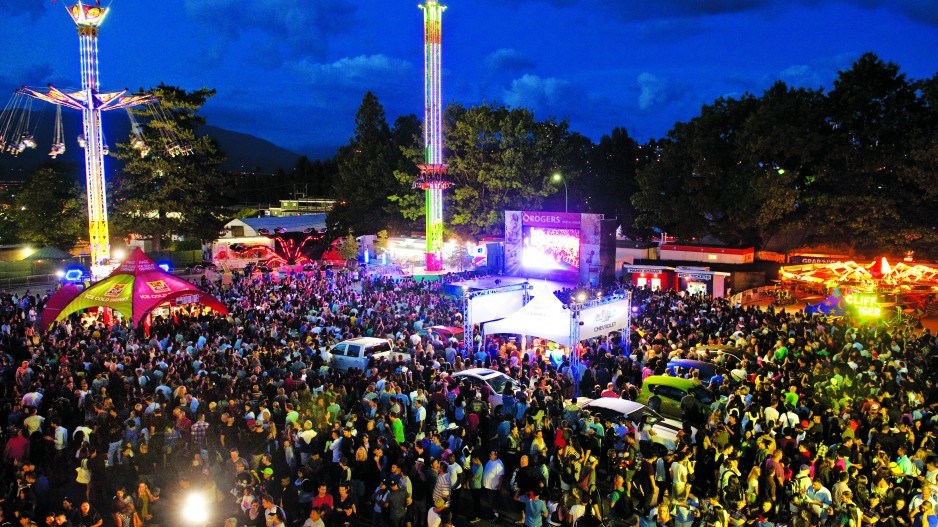Michael McDaniel has a chronic challenge on his hands when it comes to running the Fair at the Pacific National Exhibition (PNE).
“Every annual event in the world has this problem, and the longer they run as an annual event, the more of a problem they have,” said McDaniel, president and CEO of the PNE.
“When you have an annual event that happened last year, that’s going to happen next year and is going to happen 10 years from now and 100 years from now, why do guests need to come this year?”
That’s the $25 million question.
At 106 years old, the fair has established itself as an all-ages Vancouver tradition. Once a year over 15 days, hundreds of thousands of guests visit the park on East Hastings to check out SuperDogs, tour the PNE prize home and indulge in fair food that widens eyes and waistlines – all of which play their part in generating on average $25 million in revenue and attracting some 760,000 guests to the PNE each August.
When it comes to hitting those 10-year averages – as McDaniel plans to do this year – the fair has had to look beyond simply offering fan favourites.
“Vancouver is a city that you could almost do anything in, any day, within a short, medium or long drive,” said McDaniel, who added that his competition is essentially anything anyone would rather do – be it visiting the beach or heading to Whistler.
“There are too many options to choose from. So what we need to try to do is to cut through all of that so that people commit to coming to the fair,” he said.
For the PNE, that call to action has taken the form of “new and this-year-only” programming.
It includes Alien Worlds and Androids, a free exhibit that explores the science behind robotics and space exploration, and this year’s marquee event, which features magicians from around the world.
The fair, which is scheduled to run from August 20 to September 5, is also bringing the Angry Birds Universe Exhibit to North America: a 20,000-square-foot interactive showcase that allows guests to live the game.
“I’ve never played the game, but I’ve heard of it,” said McDaniel. “What we’re looking for is programming that will have messaging that will penetrate different groups, whether it be the kids, whether it be the parents of the kids, whether it be the grandparents of the kids. We want to have something that speaks to all of them.”
For the fair, “all of them” is everyone between the ages of two and 92, and finding messaging that speaks to people from different cultural, economic and geographic backgrounds has been a challenge the PNE began tackling in 2013 with the launch of its five-year revitalization strategy.
“Rather than taking a mass approach to the PNE, they are trying to be much more refined in their efforts by targeting much more refined market segments,” said Darren Dahl, senior associate dean and director of the Robert H. Lee Graduate School at the University of British Columbia.
“It’s an evolution or a more mature approach to their marketing where they’re actually trying to give out a value proposition to different segments.”
The Fair’s Fun Run – which targeted a lifestyle-focused market segment – was launched last year, and saw 1,400 participants turn out to run through the fairgrounds before the fair opened. It’s back again this year, as is the craft beer fest the PNE developed to attract craft beer drinkers.
“Beer fests are not new anymore, especially in this region, but it was new to the fair,” said McDaniel. “It was a new demographic for us. They didn’t just come for the beer festival, but they came to do that, and before it and after it they took in the rest of the fair.”
McDaniel is now more than halfway through implementing the fair’s revitalization strategy, which aims to turn the event into a must-see attraction. As it stands, the fair is the organization’s largest initiative and responsible for approximately 50% of the PNE’s annual revenue.
Beyond that, McDaniel said the PNE could seek fairer weather by moving the fair to the start of summer, come 2018. The PNE links last year’s windstorm – which left hundreds of thousands of households without power – to a 7.7% drop in revenue and a 12% drop in attendance compared with 2014 figures.
The fair is also part of the larger Playland Redevelopment Plan, which the City of Vancouver initially approved earlier this year, pending a more comprehensive implementation and funding report.
If fully approved, the 10-year, $120 million redevelopment would expand the park to 22 acres from the current 15 acres. At its current size, the fair annually brings in 12 to 17 extra rides to accommodate guest demand. More space would allow the PNE to increase its number of permanent rides – rides that would generate revenue for the PNE rather than outside companies.
“We were able to turn the discussion around and have everybody realize that you have to have tradition and innovation all wrapped up in one,” said McDaniel. “We’ve got the tradition, we’ve got some of the innovation and we’re working on more.”




